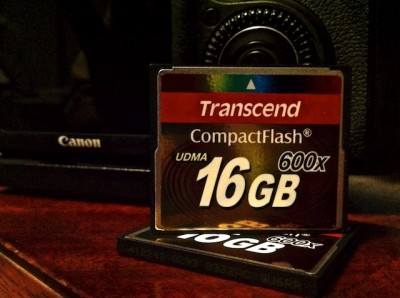
B&H Photography has graced me with some new CF cards — a pair of Transcend 16GB 600X cards!
I’ve been pining for new cards for a while. My largest card — a Sandisk 16GB Extreme III — was plenty fast enough in my 40D, but was lacking on the 7D. When I shot the Three State Three Mountain Challenge from Mom’s driveway a few weeks ago, I kept having to pause to let the buffer on the camera clear. Admittedly, I was shooting RAW (probably shoulda been shooting JPEG), and was shooting big bursts as the cyclists went by… but still… waiting for the buffer to clear was painful. Since it was just an experimental shoot for me, there was nothing lost by having to wait occasionally. Doesn’t mean I enjoyed waiting!
I’ve been looking at faster CFs since I bought my 7D over a year ago. I don’t often need speed, so I haven’t really pursued it real hard. I’d seen a tweet from someone extolling the virtues of the relatively new Transcend cards, and that piqued my interest again. When I was at the Canon EOS Immersion Seminar last weekend, Transcend’s name came up again, alongside Lexar and Sandisk. My fate was cast. If the folks representing Canon, who told us to use good cards and beware the cheap stuff, still had Transcend up on the big screen with the big kids of flash cards, then that was good enough for me.
The cool thing about these cards is the price. B&H has ’em for about $75/ea for 16GB cards. At 32GB, they’re more than twice the price of the 16GB’s. The good news is that at $75 for 16GB, they are way under half the price of their Sandisk counterparts.
And BTW, for me, going to 32GB cards sounds attractive, but if I lose a card — which in nine years of shooting has never happened (except for the old microdrive cards, which were disastrous for me) — I simply lose too much at 32GB. And frankly, it’s rare that I can’t take the time to change cards. My subjects just ain’t that dynamic typically!
So, how’s the performance?
In camera, they seem pretty dang fast. Compared to my Sandisk 16GB card, I overran the buffer after about 23 shots and started pausing between images. However, the buffer seemed to clear much more quickly with the Transcend than the Sandisk. Shooting JPEG, the difference was much more pronounced.
Shooting large JPEG, the Sandisk card gave me about 28 seconds of shooting (approx 200 images) before there was a pause. The Transcend card? Well, let’s just say that I stopped after 40 seconds (approx 280 images). I mean, when am I gonna shoot 40 seconds solid of something?!
I’m pleased so far, and can’t wait to get this little guys out in the field. If they pan out like they appear they could, I’m pretty sure there’ll be more of ’em in my bag, replacing some cards that are long-in-the-tooth.
